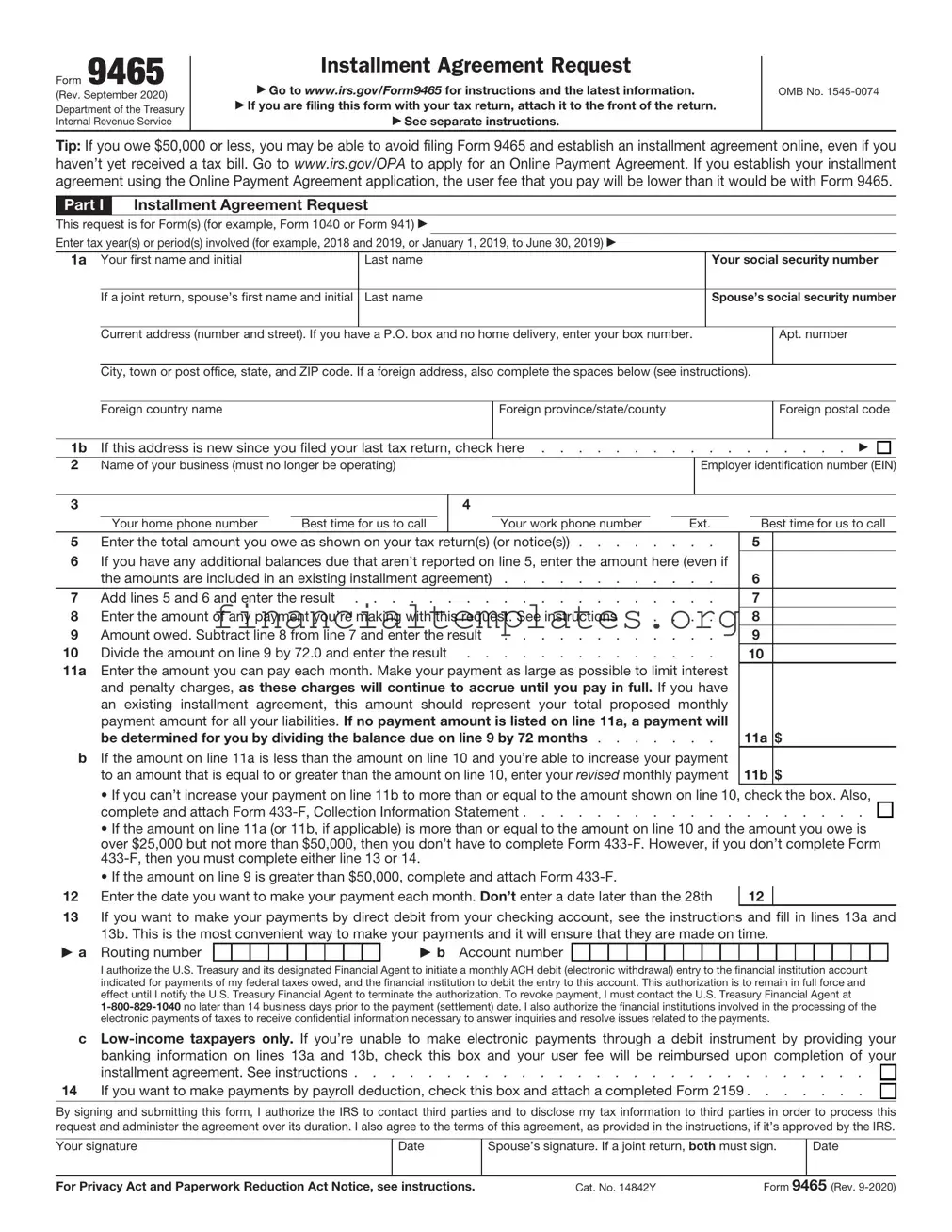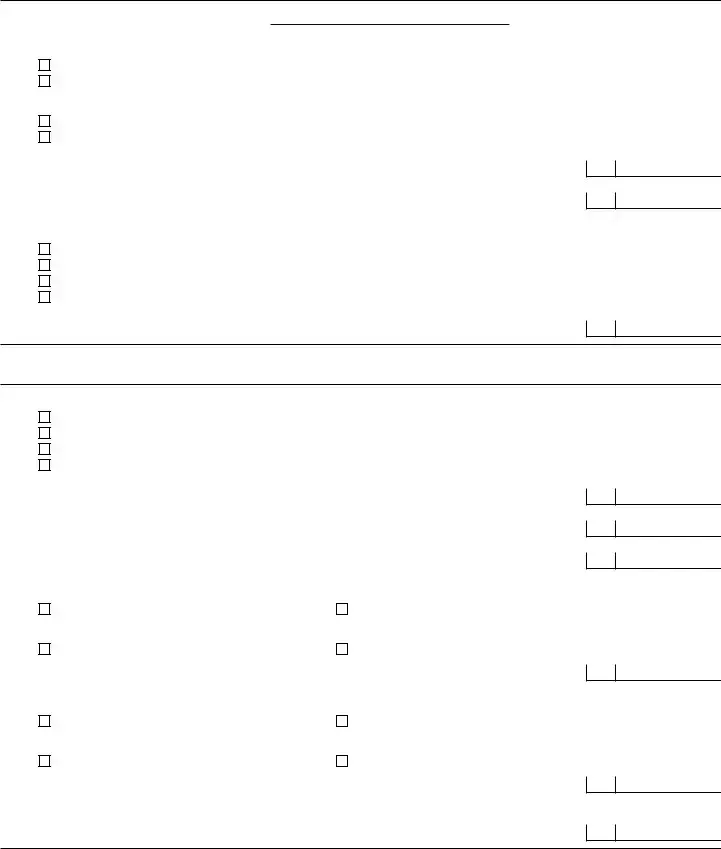Tip: If you owe $50,000 or less, you may be able to avoid filing Form 9465 and establish an installment agreement online, even if you haven’t yet received a tax bill. Go to www.irs.gov/OPA to apply for an Online Payment Agreement. If you establish your installment agreement using the Online Payment Agreement application, the user fee that you pay will be lower than it would be with Form 9465.
Part I Installment Agreement Request
This request is for Form(s) (for example, Form 1040 or Form 941)
Enter tax year(s) or period(s) involved (for example, 2018 and 2019, or January 1, 2019, to June 30, 2019)
City, town or post office, state, and ZIP code. If a foreign address, also complete the spaces below (see instructions).
|
Foreign country name |
Foreign province/state/county |
Foreign postal code |
|
|
|
|
1b |
If this address is new since you filed your last tax return, check here |
2 |
Name of your business (must no longer be operating) |
|
|
|
|
|
Employer identification number (EIN) |
|
|
|
|
|
|
|
|
|
|
|
|
|
|
|
3 |
|
|
|
|
4 |
|
|
|
|
|
|
|
|
|
|
|
|
|
|
|
|
|
|
|
|
|
Your home phone number |
Best time for us to call |
Your work phone number |
Ext. |
Best time for us to call |
5 |
Enter the total amount you owe as shown on your tax return(s) (or notice(s)) |
. . . |
|
5 |
|
6 |
If you have any additional balances due that aren’t reported on line 5, enter the amount here (even if |
|
|
|
|
|
the amounts are included in an existing installment agreement) |
. . . |
|
6 |
|
7 |
Add lines 5 and 6 and enter the result |
. . . |
|
7 |
|
8 |
Enter the amount of any payment you’re making with this request. See instructions . . |
. . . |
|
8 |
|
9 |
Amount owed. Subtract line 8 from line 7 and enter the result |
. . . |
|
9 |
|
10 |
Divide the amount on line 9 by 72.0 and enter the result |
. . . |
|
10 |
|
11a |
Enter the amount you can pay each month. Make your payment as large as possible to limit interest |
|
|
|
|
|
and penalty charges, as these charges will continue to accrue until you pay in full. If you have |
|
|
|
|
|
an existing installment agreement, this amount should represent your total proposed monthly |
|
|
|
|
|
payment amount for all your liabilities. If no payment amount is listed on line 11a, a payment will |
|
|
|
|
|
be determined for you by dividing the balance due on line 9 by 72 months . . . . |
. . . |
|
11a $ |
bIf the amount on line 11a is less than the amount on line 10 and you’re able to increase your payment
to an amount that is equal to or greater than the amount on line 10, enter your revised monthly payment
• If you can’t increase your payment on line 11b to more than or equal to the amount shown on line 10, check the box. Also, complete and attach Form 433-F, Collection Information Statement . . . . . . . . . . . . . . . . . . .
•If the amount on line 11a (or 11b, if applicable) is more than or equal to the amount on line 10 and the amount you owe is over $25,000 but not more than $50,000, then you don’t have to complete Form 433-F. However, if you don’t complete Form 433-F, then you must complete either line 13 or 14.
•If the amount on line 9 is greater than $50,000, complete and attach Form 433-F.
12 Enter the date you want to make your payment each month. Don’t enter a date later than the 28th |
12 |
|
13If you want to make your payments by direct debit from your checking account, see the instructions and fill in lines 13a and 13b. This is the most convenient way to make your payments and it will ensure that they are made on time.
a Routing number |
|
|
|
|
|
|
|
|
|
b Account number |
I authorize the U.S. Treasury and its designated Financial Agent to initiate a monthly ACH debit (electronic withdrawal) entry to the financial institution account indicated for payments of my federal taxes owed, and the financial institution to debit the entry to this account. This authorization is to remain in full force and effect until I notify the U.S. Treasury Financial Agent to terminate the authorization. To revoke payment, I must contact the U.S. Treasury Financial Agent at
1-800-829-1040 no later than 14 business days prior to the payment (settlement) date. I also authorize the financial institutions involved in the processing of the electronic payments of taxes to receive confidential information necessary to answer inquiries and resolve issues related to the payments.
cLow-income taxpayers only. If you’re unable to make electronic payments through a debit instrument by providing your banking information on lines 13a and 13b, check this box and your user fee will be reimbursed upon completion of your
installment agreement. See instructions . . . . . . . . . . . . . . . . . . . . . . . . . . . .
14 If you want to make payments by payroll deduction, check this box and attach a completed Form 2159 . . . . . . .
By signing and submitting this form, I authorize the IRS to contact third parties and to disclose my tax information to third parties in order to process this request and administer the agreement over its duration. I also agree to the terms of this agreement, as provided in the instructions, if it’s approved by the IRS.


